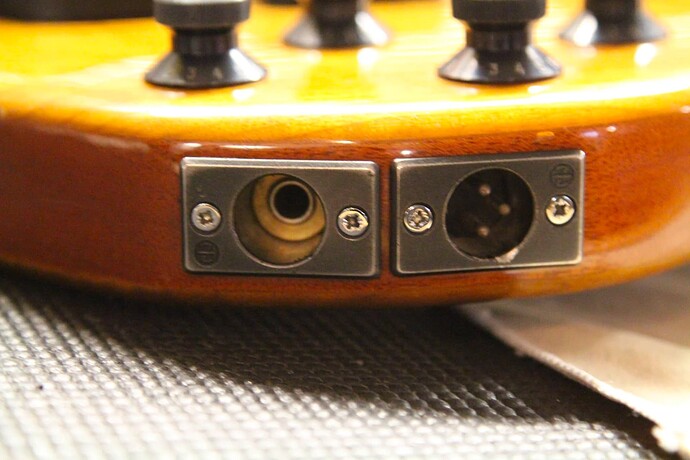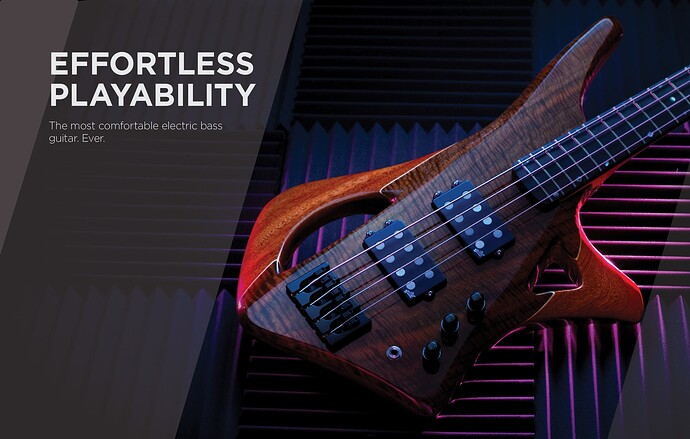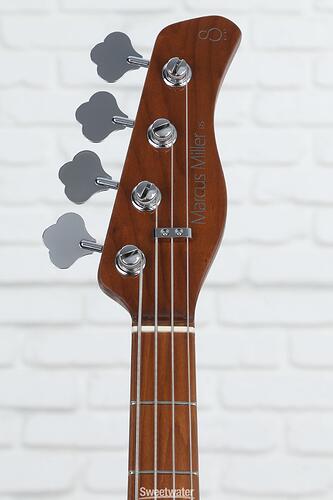I’m trying to design a new bass for my assignment so please tell me about the things you like about your instrument, things you dislike and things would like to see improved.
This is probably extremely hard to provide good input here. What someone will point out as a thing they dislike, someone else will state that it is the best thing about the instrument. And the other way round…
Perhaps one thing that almost everybody agrees is annoying is “neck dive”, where the neck (typically because of the headstock) is following gravity and dipping downwards, and the player has to constantly use energy (and awareness) to keep the neck from diving. So, a balanced instrument is a must. (That is one reason for headless designs, but many people find headless designs not esthetically pleasing or visually confusing when trying to play on the first frets).
Also, many of us would prefer lighter instruments (to help ease strain on our necks and shoulders), which, however, still have “heft”, i.e., don’t feel flimsy or even cheap. One way to achieve this is to “chamber” the body of the bass (rout out cavities in the body), but this may in fact aggravate the above-mentioned neck dive (imbalance) issue.
Good luck!
Thanks for the tips. I’ll definitely keep these in mind while designing.
My pet peave is most basses have such a small cutout, its hard to reach the higher frets. Your design should have a wide cutout, making it easier to reach the high frets.
Both TRS and XLR output. Wal basses have them (I think also some alembics, foderas maybe some other).
Thanks for the suggestion. I’ll definitely keep that in mind for the design. ![]()
May I ask why you would want a XLR output? Just curious.
Agree. Curious as to why you would want a direct XLR from the bass before going to an amp.
I don’t think you are going to come up with any revolutionary new design as pretty much everything has been tried before. The Fender P and J are the “standard” baseline designs.
To prevent neck dive, most people want an upper horn that extends to at least the 12th fret of the neck. There is debate over whether it is best to have all 4 tuners in-line on the top of the headstock (like fender) or with the G on the top (like Music Man). The 2 on a side Gibson design usually requires an angled headstock, which can be prone to cracks/breaks.
Other design considerations are really personal. Most people like “belly contours” rather than “slabs” so the bass sits better when standing. If it is meant to be played seated, then you are going to want one or two cutaways on the “floor” side of the instrument to make the bass sit on or between someone’s legs.
Other design considerations are going to be dictated by pickup choice and whether the amp will be active or passive and whether you want the controls attached to a pickguard or in a control cavity on the rear.
Oh, and you want the cutaway for the lower horn to be deep enough so the player can easily access the end of the fretboard.
I am not a design student, but designed and built my own bass body a few years ago, so I read and though a lot about all of these things. This was my final product:
Other thoughts:
Some folks like a contour where the plucking arm will come over the bass.
Minimum length of the bass will be dictated by the scale length and where you want the bridge. A longer body with the bridge far from the edge will result in a very “long feeling” bass–ala the Thunderbird, as the longer the body is, the further away the neck pocket will be from the rear strap button.
IMHO, controls are best to the lower left, if you position them higher, near the horn, they can get in the way of aggressive picking.
If you google “ergomonic bass guitar designs” you can see some pretty funky and neat looking designs, such as:

or
You can check out our “bass porn” thread for for boutique design ideas
Dense wood and MFD pickups
XLR is too bulky for me, but I do want a TRS connection with a balanced output preamp on an active bass. I can’t understand why adding an active circuit wouldn’t be balanced. Other than causing cable confusion.
The TRS connector can also be used to provide two outputs from the bass, one for each pickup. That way different pickups could go to different cabinets, be processed differently or be used to create a stereo effect.
People wrestle with where to rest their thumb if the pickup isn’t in the spot where they want to pluck. Thumb rests and pickup ramps are sometimes mods that could be part of an original design.
For going directly to a mixer. I would actually like this a lot. But as @DaveT says, balanced TRS to XLR would work fine too.
Not everyone uses an amp. Amps are pretty optional (I’d almost say “useless”) for recording these days, and for live, mixer to PA is a good choice too.
*cutaway
I rarely turn my amp on anymore. I practice and record ŵith the studio monitors out of my DAI. Ànd for recording, as you say, the amp is useless.
For a gig or jam, i would lug my 500 watt amp head and cab ŵith me, unless there’s a sound setup at the vènue.
Im really curious why anyone would want an XLR output on their bass ŵhen they can just plug into a DAI or mixer.
For if you want a balanced output on the bass to run in to a balanced XLR input. It’s a nice touch, I would like it. I wouldn’t say it is critical but I can see why someone would want it.
Could you just do a combined XLR/TRS jack? They seem inexpensive.… or is the problem the electronics on the bass side connecting to it?
Exactly this and as @PamPurrs said it is a nice touch. For a design exercise it is a really nice discussion to be had.
You have balanced input in your DAI. Some amps have balanced inputs as well.
There price was not part of the question ![]()
If you don’t angle the headstock, you will want to add a string tree so the strings get a proper break angle from the nut to the tuners. Improper break angle can cause intonation issues and is a common defect on Fender style headstocks.
You can see the string tree holding down the A D and G strings
I would suggest you figure out your target player for the bass. I would probably never buy a bass with an XLR output. It’s an advanced option, and many players wouldn’t know what it’s for.
So some design questions you have to answer
- how many strings do you want. 4, 5, or 6.
- What’s the scale length, 30" (4 string only) and 34" the most common. Scale length is the distance from the bridge to the nut
- where do you place the pickup/pickups. This will have a huge impact on your sound
- what kind of pickups do you want. Again, huge impact and a lot of choices and combinations
- what kind of electronics do you want- active (preamp) or passive (tone and volume only). Active basses will require a battery compartment
I am sure I am forgetting some. There’s no right or wrong answers, these are choices you have to make. Really starts with what sound do you want the bass to produce. Will narrow some of the choices when you decide that



